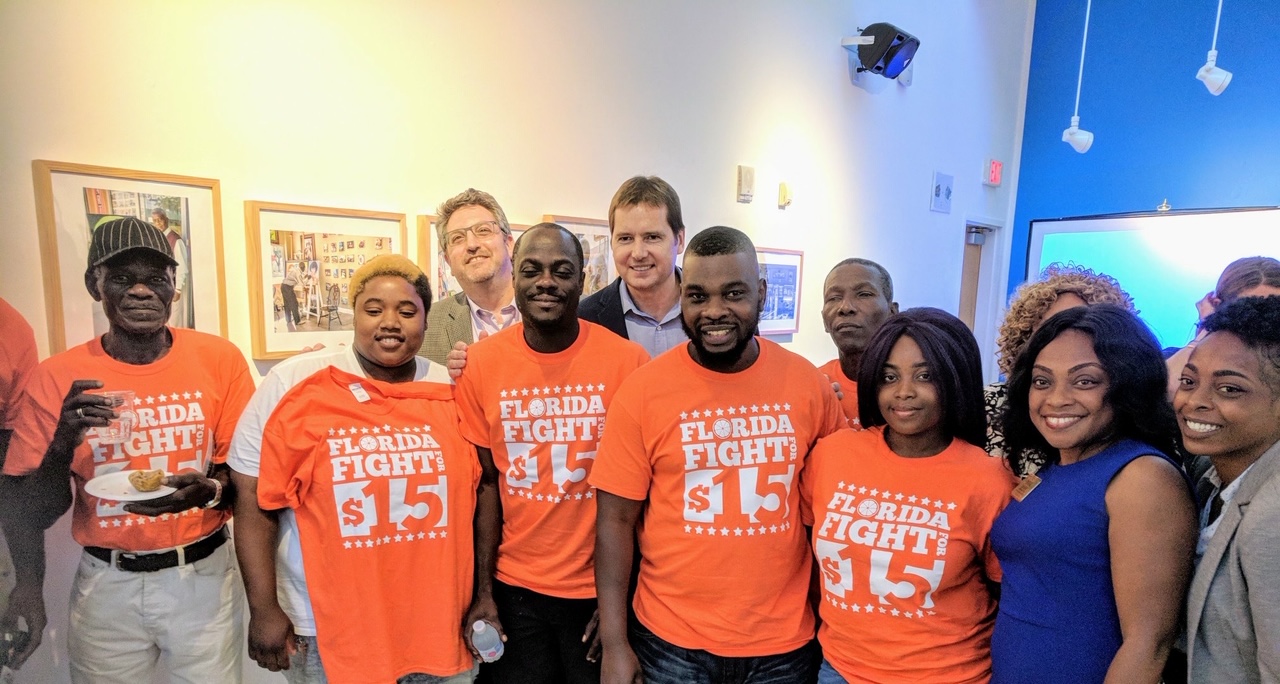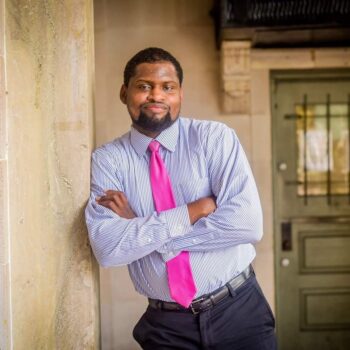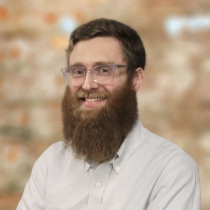This past November, Floridians turned out in record numbers to vote for a raise, casting more ballots in favor of the new $15 minimum wage than for either Trump or Biden. Kofi Hunt, a working-class organizer who helped lead Florida for $15, sat down with The Forge to talk about how they laid the groundwork for the campaign and what it took to build a coalition that delivered real change for working families in Florida.
How did Florida for $15 come together, and how did previous grassroots organizing efforts help seed the fight?
The Fight for $15 actually is really interesting. When I was working on the swing district’s campaign in 2012, one of our biggest projects was a campaign for a $10 minimum wage, and that was thought of as pretty radical. We collected thousands of petitions and bird dogged people saying, “Why don’t you support a $10 minimum wage?” We went to then Congressperson Bill Young, who was the longest-serving person in the House and he told our activist repeatedly, “Why don’t you just get a job, just get a job,” and the worker responded: “I have a job, and I still don’t make enough money.”
That went viral, and overnight it had 60,000 views on YouTube and it had 300 news articles nationwide. That December, SEIU decided to fund its pilot project where they went and organized fast food workers, and hundreds of fast food workers from all over New York came out at a McDonald’s to go on a one-day strike calling for a $15 minimum wage. That’s when the Fight for $15 started. In 2013, SEIU organized a Burger King in Florida. I think we had maybe thirty people out there but the media was all in our face. [Fast food workers were] going on strike, a walkout. It was like a revolution. We had helicopters out there, everything.
From there, SEIU decided to fund the operation more and more. They split the campaign into several different things. They had a home healthcare campaign, they had a childcare campaign, adjunct professor campaign, and the fast food campaign. I was the community organizer coordinating with all of them to turn out for different events. We did that through 2016. Then, around 2018, a trial attorney out of Orlando decided [to fund a $15 minimum wage] ballot initiative. He has the funds personally for that, so he started the petition drive for the $15 minimum wage. We laid the groundwork [for that].
The coalition that came together to help pass the ballot initiative represented community, immigrant, and labor organizations from across the state. How did folks come together, and how did you keep everyone at the table throughout such a challenging period once COVID hit?
We had been doing the work for quite a while. We had a lot of relationships throughout Florida so we basically just reached out to our partners. I think we did something like twenty demonstrations in one day between ourselves and our allies all over the state of Florida so we just were able to tap into that network. Everyone who’s concerned with progressive justice has an interest in the minimum wage, in Amendment 2. It applies to everyone. We started convening everybody and brought together weekly calls.
It sounds like this was a natural rallying post for everybody in the progressive movement. How centralized was the campaign versus how organic and free flowing was it? In a state as big and diverse as Florida, how did you coordinate the coalition?
We as a coalition had that centralized weekly call. But besides that, yeah, everyone had their different direction they were taking on things. There was a coordinated campaign that was affiliated with the work we did, and they were actively bringing volunteers and partners to do text banking. DSA did a lot of text banking, for instance. We’re able to avail people of that space and how they could get involved there and help to push phone banking and text banking. I think we did a little bit of canvassing towards the end. It was kind of like, everyone’s kind of doing their own thing, particularly in the role of media. But then, we’re able to direct people to volunteer opportunities as well.
What sort of strategy and tactics did you employ to reach voters and how did they change after COVID?
In 2018 and 2019, there was a funded petition drive. We did a decent amount of volunteer petition gathering as well, and we were actually able to collect all the petitions before the pandemic hit. Thankfully, we cleared all those hurdles [to get on the ballot] before everything shut down and we had a lockdown. [Once the pandemic hit,] it turned to more earned media, more digital organizing, more Zoom, town halls, and those sorts of things. The basic idea was just that if we can raise the information for voters, then voters would vote for it. It was a great motivator but it’s the same problem we have for every election. People don’t know what’s going on. They don’t know what’s on the ballot.
The $15 minimum wage amendment earned more votes than either Trump or Biden got.
Yeah, it got 300,000 more votes than Trump did. And Trump got almost 300,000 more votes than Biden did. Honestly, the best thing we did was the earned media because most of our targeted average was directed to voters that would typically be liberal to progressive. It wasn’t like we were doing really outreach to the Republicans or right-leaning Independents. It was just that at the end of the day, I think people saw their interest and they voted their interest.
If it’s laid out that explicitly, I think it’s hard for them to say no. Florida is a working-class state. Most people are working-class people and they understood they make minimum wage. Outside of my work for Fight for $15, just being a member of DSA, we’re canvassing for Bernie in January of 2020. We knocked on doors of people who were younger Democrats, like under forty Democrats, and working class, white working-class areas. We’re like, “Did you know that there’s a $15 minimum wage? It’s going to be on the ballot in 2020?” They’re like, “No.” “Would you vote for that?” “Yeah, I’d vote for that, definitely.”
Then, “If you don’t mind us asking, who do you plan on voting for president?” They’re like, “Trump.” We’re like, “Oh, okay.” They’re like, “Yeah, that’s my guy.” We’re like, “Okay.” That was the sentiment. That happened several times. These are Democratic voters or usually, Democrats. You had that phenomenon where for whatever reason, white working-class Floridians relate to Trump. But at the same time, they support the $15 minimum wage.
Running a statewide campaign in Florida is no small feat. Tell us about some of the challenges that you faced on the campaign.
The main challenge was the pandemic, that you had a movement that’s very well-versed in canvassing, very well-versed in owning public events, large mass events, and we couldn’t do that. So, we had to figure out a way to get around that. At the end of the day, I think that we were able to do that both in terms of creating avenues for people to be involved digitally and, even more to that point, to creating digital content that went farther. We had to try to run a campaign and deal with [pandemic-related] issues, people dying, getting laid off. You’re talking about, “Let’s go get on the call and talk about phone banking”; they’re just like, “I can’t do that right now.”
I could tell you, as someone that’s organized for the past few years, it was really interesting because I believe in using all tools and I believe in pursuing all different strategies. But the truth is that, a lot of grassroots organizers were vehemently opposed to online organizing. They thought it was soulless, they thought it was impersonal. I even had some people refuse to even make a Facebook event because they were like, “That’s a waste. That’s lazy.” That transition was the most challenging thing of 2020 in organizing.
The people who have organized during the pandemic have real lessons learned from this. What are some of the innovations, best practices, or new power-building tools that you’ve picked up over the course of organizing throughout the pandemic, that you think even when this is over, organizers should take forward?
Honestly, one of the biggest things is Zoom. I was having a one-on-one with an unemployed worker today and she was like saying, “Look, if the pandemic did not happen, we would’ve never met.” She’s like, because of Zoom she’s met people from all over the country that she probably would’ve never met. I think that it made the world smaller and it made people’s organizing bigger.
And I think because of that, there’s a good likelihood that people that are willing to retain these sorts of digital tools going back into the world where they can do face-to-face mass mobilizations again. I think we’re going to be able to create an amazing interconnective movement. I’ve heard for a long time how, if you want a true left or right, it can’t just be in your city, it can’t just be in our county, it can’t just be in your state, and can’t just be in your nation, it has to be global. I think that we’ve, in a lot of ways, laid the groundwork for the global left to really rise. I don’t know who’s going to build it, but I look forward to seeing it grow because it’s what is necessary to get to where we need to be.


